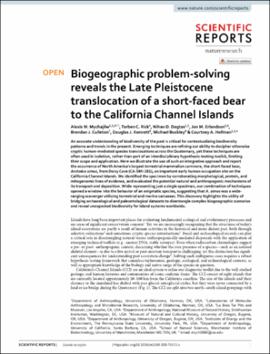| dc.contributor.author | Mychajliw, Alexis M. | |
| dc.contributor.author | Rick, Torben C. | |
| dc.contributor.author | Dagtas, Nihan D. | |
| dc.contributor.author | Erlandson, Jon M. | |
| dc.contributor.author | Culleton, Brendan J. | |
| dc.contributor.author | Kennett, Douglas J. | |
| dc.contributor.author | Buckley, Michael | |
| dc.contributor.author | Hofman, Courtney A. | |
| dc.date.accessioned | 2020-10-01T15:23:38Z | |
| dc.date.available | 2020-10-01T15:23:38Z | |
| dc.date.issued | 2020-09-16 | |
| dc.identifier.citation | Mychajliw, A.M., Rick, T.C., Dagtas, N.D. et al. Biogeographic problem-solving reveals the Late Pleistocene translocation of a short-faced bear to the California Channel Islands. Sci Rep 10, 15172 (2020). https://doi.org/10.1038/s41598-020-71572-z | en_US |
| dc.identifier.uri | https://hdl.handle.net/11244/325582 | |
| dc.description.abstract | An accurate understanding of biodiversity of the past is critical for contextualizing biodiversity patterns and trends in the present. Emerging techniques are refining our ability to decipher otherwise cryptic human-mediated species translocations across the Quaternary, yet these techniques are often used in isolation, rather than part of an interdisciplinary hypothesis-testing toolkit, limiting their scope and application. Here we illustrate the use of such an integrative approach and report the occurrence of North America’s largest terrestrial mammalian carnivore, the short-faced bear, Arctodus simus, from Daisy Cave (CA-SMI-261), an important early human occupation site on the California Channel Islands. We identified the specimen by corroborating morphological, protein, and mitogenomic lines of evidence, and evaluated the potential natural and anthropogenic mechanisms of its transport and deposition. While representing just a single specimen, our combination of techniques opened a window into the behavior of an enigmatic species, suggesting that A. simus was a wide-ranging scavenger utilizing terrestrial and marine carcasses. This discovery highlights the utility of bridging archaeological and paleontological datasets to disentangle complex biogeographic scenarios and reveal unexpected biodiversity for island systems worldwide. | en_US |
| dc.description.sponsorship | Open Access fees paid for in whole or in part by the University of Oklahoma Libraries
Radiocarbon and isotope laboratory work was supported in part by the NSF Archaeometry Program BCS-1460369 (to D.J.K. and B.J.C). M.B was supported by a Royal Society fellowship. Additional funding was provided by the University of Oklahoma, the University of Oregon, and the Smithsonian Institution. | en_US |
| dc.language | en_US | en_US |
| dc.rights | Attribution 4.0 International | * |
| dc.rights.uri | https://creativecommons.org/licenses/by/4.0/ | * |
| dc.subject | Arctodus simus | en_US |
| dc.subject | Short-Faced Bear | en_US |
| dc.subject | Daisy Cave | en_US |
| dc.subject | California Channel Islands | en_US |
| dc.subject | Biodiversity | en_US |
| dc.subject | Late Pleistocene | en_US |
| dc.title | Biogeographic problem-solving reveals the Late Pleistocene translocation of a short-faced bear to the California Channel Islands | en_US |
| dc.type | Article | en_US |
| dc.description.peerreview | Yes | en_US |
| dc.identifier.doi | 10.1038/s41598-020-71572-z | en_US |
| ou.group | College of Arts and Sciences::Department of Anthropology | en_US |

